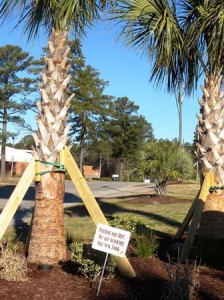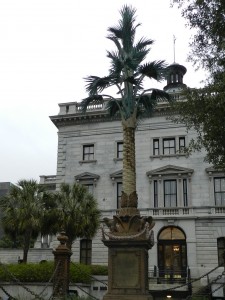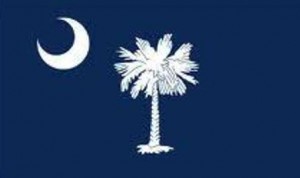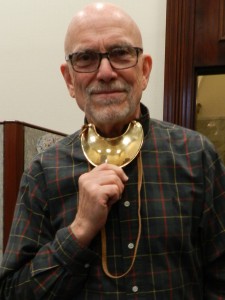» posted on Tuesday, February 19th, 2013 by Linda Lou Burton
Bootjacks And Cabbages
 Linda Burton posting from Columbia, South Carolina – “About $800.00” That was the answer to my question, “How much does a big tree like that cost?” I was referring to the large palmetto trees on the grounds of my hotel, propped securely in place by a system of support boards angled to hold them upright. The newly planted trees are more than twenty feet tall at the moment, offering a “South Carolina look” on each side of the doorway. They have been planted at the entrance to the parking lot as well; the signs beside read “Pardon Our Dirt.” A South Carolina look? For sure; the palmetto is the state tree and has been on the state flag since 1861. It is part of the design on the state quarter, issued in 2000, and its image occupies the center spot on the South Carolina vehicle license plate. Real live palmettos frame almost every residential lawn and there is even a “Palmetto Trail”
Linda Burton posting from Columbia, South Carolina – “About $800.00” That was the answer to my question, “How much does a big tree like that cost?” I was referring to the large palmetto trees on the grounds of my hotel, propped securely in place by a system of support boards angled to hold them upright. The newly planted trees are more than twenty feet tall at the moment, offering a “South Carolina look” on each side of the doorway. They have been planted at the entrance to the parking lot as well; the signs beside read “Pardon Our Dirt.” A South Carolina look? For sure; the palmetto is the state tree and has been on the state flag since 1861. It is part of the design on the state quarter, issued in 2000, and its image occupies the center spot on the South Carolina vehicle license plate. Real live palmettos frame almost every residential lawn and there is even a “Palmetto Trail”  through the state, connecting the mountains of South Carolina to the coast, and running right through the state capitol lawn in downtown Columbia. The sabal palmetto, also known as the “cabbage palm” is the state tree of Florida too, and is native to the subtropical warm and temperate southeastern United States, as well as Cuba and the Bahamas. Can you guess why it is called a “cabbage” palm? And what on earth is a bootjack?
through the state, connecting the mountains of South Carolina to the coast, and running right through the state capitol lawn in downtown Columbia. The sabal palmetto, also known as the “cabbage palm” is the state tree of Florida too, and is native to the subtropical warm and temperate southeastern United States, as well as Cuba and the Bahamas. Can you guess why it is called a “cabbage” palm? And what on earth is a bootjack?
I’ve been doing some reading about this interesting icon, a fan palm that may grow up to 65 feet tall and tolerates just about anything from drought to standing water to hurricane winds  to sweltering heat. The “cabbage” part is the growing heart of new leaves (fronds); it’s the bud, and is similar to the heart of a cabbage or artichoke. This bud is used to make “heart of palm” salad and from some species that’s okay; however, removing the bud from the sabal palmetto kills it. Without its bud it cannot replace old leaves and eventually dies; so, hands off the cabbage palm if you’re thinking about lunch.
to sweltering heat. The “cabbage” part is the growing heart of new leaves (fronds); it’s the bud, and is similar to the heart of a cabbage or artichoke. This bud is used to make “heart of palm” salad and from some species that’s okay; however, removing the bud from the sabal palmetto kills it. Without its bud it cannot replace old leaves and eventually dies; so, hands off the cabbage palm if you’re thinking about lunch.
Natives were likely eating the cabbage palm’s bud when Europeans began to arrive however; the trees were a grand resource. Food and shelter, first needs; but through the ages various uses have been found for its bits and parts. The sheaths of young leaves have been made into scrubbing brushes; the trunks have been used as wharf piles. Or make a fort with them! William Moultrie did that back in 1776, when Charleston patriots successfully defended against the British in the Revolutionary War.
 So what about those bootjacks? Bootjacks, as a tool, are simply Y-shaped devices that help you get into and out of your boots; they are heavy-duty shoehorns. Now, look closely at the trunk of the sabal palmetto; I’m about to make you an expert. See the spiky, basketweave area along the midpart of the trunk, below the leaves and above the propping boards? These are old leaf bases; as the tree grows in height, the old leaves fall away, but these former leaf bases remain on the trunk for a while. These bases are called “bootjacks” simply because they resemble those shoehorn devices. Now you’re an expert! But what about the smooth trunk below the bootjacks in the photo? Bootjacks eventually fall away, leaving a smooth trunk, but generally when trees are replanted the nursery removes the bootjacks; whether for beauty or ease of handling I don’t know, but it makes for an attractive package, overall.
So what about those bootjacks? Bootjacks, as a tool, are simply Y-shaped devices that help you get into and out of your boots; they are heavy-duty shoehorns. Now, look closely at the trunk of the sabal palmetto; I’m about to make you an expert. See the spiky, basketweave area along the midpart of the trunk, below the leaves and above the propping boards? These are old leaf bases; as the tree grows in height, the old leaves fall away, but these former leaf bases remain on the trunk for a while. These bases are called “bootjacks” simply because they resemble those shoehorn devices. Now you’re an expert! But what about the smooth trunk below the bootjacks in the photo? Bootjacks eventually fall away, leaving a smooth trunk, but generally when trees are replanted the nursery removes the bootjacks; whether for beauty or ease of handling I don’t know, but it makes for an attractive package, overall.
 The hotel manager tells me that large sabal palmettos, aka cabbage palms, can be replanted without harm because their rootballs are compact. These trees will easily survive their new home, and in addition to that, they can survive cold spells, to a point, such as we had when I found myself scraping ice off the windshield yesterday morning before the sun could warm things up. Palmettos are adaptable, they are versatile, and like I said, they are everywhere; there is even an iron palmetto downtown. It’s a monument honoring the men of the Palmetto Regiment who fought in the Mexican War, and has been on the State House grounds since 1858; today the palmetto state flag flutters above.
The hotel manager tells me that large sabal palmettos, aka cabbage palms, can be replanted without harm because their rootballs are compact. These trees will easily survive their new home, and in addition to that, they can survive cold spells, to a point, such as we had when I found myself scraping ice off the windshield yesterday morning before the sun could warm things up. Palmettos are adaptable, they are versatile, and like I said, they are everywhere; there is even an iron palmetto downtown. It’s a monument honoring the men of the Palmetto Regiment who fought in the Mexican War, and has been on the State House grounds since 1858; today the palmetto state flag flutters above.
 Take a close look at that state flag; a basic blue flag with a crescent in the corner and a palmetto in the center, where it’s been since 1861. The crescent has been there even longer, and there is controversy as to its origins. South Carolina’s revolutionary soldiers had the crescent on their caps; but its significance seems to be more legend than fact. In English heraldry a crescent is the cadence mark of a second son; many early colonists were second sons who were not entitled to an inheritance in England and therefore came to America to seek their fortune. Could that account for its early usage, and meaning? Another theory is that it came from
Take a close look at that state flag; a basic blue flag with a crescent in the corner and a palmetto in the center, where it’s been since 1861. The crescent has been there even longer, and there is controversy as to its origins. South Carolina’s revolutionary soldiers had the crescent on their caps; but its significance seems to be more legend than fact. In English heraldry a crescent is the cadence mark of a second son; many early colonists were second sons who were not entitled to an inheritance in England and therefore came to America to seek their fortune. Could that account for its early usage, and meaning? Another theory is that it came from  the coat of arms of the Bull family, prominent in the early days of the colony. Or does it simply represent the lovely Carolina moon? Paul McCravy, a Tour Guide in the State Capitol, scoffs at that idea. “It’s clearly not a moon,” he says. “It’s a gorget.” A gorget, he went on to explain, is a part of the armor that soldiers wore; it goes back to medieval times.
the coat of arms of the Bull family, prominent in the early days of the colony. Or does it simply represent the lovely Carolina moon? Paul McCravy, a Tour Guide in the State Capitol, scoffs at that idea. “It’s clearly not a moon,” he says. “It’s a gorget.” A gorget, he went on to explain, is a part of the armor that soldiers wore; it goes back to medieval times.
The choice of the palmetto is easier to explain. With its bootjacks and cabbages, the pretty thing is simply everywhere.
